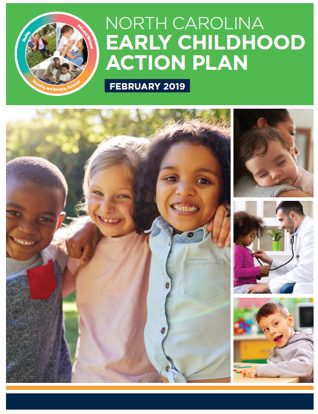Marsha Basloe, President of Child Care Services Association
Last week I had the opportunity to attend an early childhood summit in Raleigh to support the launch of the North Carolina Early Childhood Action Plan. Governor Roy Cooper, Former Governor Jim Hunt, Department of Health and Human Services Secretary Mandy Cohen, state legislators, philanthropists, advocates and early childhood leaders from across the state came to Raleigh to unite behind a 10-goal plan with measurable benchmarks to improve the lives of young children by 2025. Dr. Jack P. Shonkoff, Director of the Center on the Developing Child at Harvard University, was the keynote speaker.
North Carolina has been a national leader on early childhood initiatives over the past several decades. And during those years, much progress has been made to better meet the needs of our state’s young children. However, even with those efforts, still too many children are left behind and the health, well-being and school readiness gap between children of different races and ethnicities is stark.
Last August, Governor Cooper charged the NC Department of Health and Human Services to work with the NC Early Childhood Advisory Council to develop a statewide Early Childhood Action Plan to:
- improve young children’s health,
- support safe and nurturing environments for children and families, and
- provide high-quality early childhood learning opportunities.
The governor’s Executive Order called for strategies and timeframes for achieving the goals as well as metrics that would be publicly reported to chart progress. Nearly 1,500 people throughout the state provided suggestions and feedback on an early draft released in November 2018. Over the next six months, the plan was drafted and coordinated by Becki Planchard, MPP, Senior Early Childhood Policy Advisor at NCDHHS.
Early Childhood Action Plan Goals and Targets
Goal 1: Healthy Babies
2025 Target: By 2025, reduce the statewide infant mortality rate across by child race and ethnicity.
Goal 2: Preventive Health Services
2025 Target: By 2025, increase the percentage of North Carolina’s young children enrolled in Medicaid and Health Choice who receive regular well-child visits as part of a health care delivery process that provides comprehensive, patient-centered, accessible, quality care as recommended for the ages of young children.
Goal 3: Food Security
2025 Target: By 2025, reduce the percentage of children living across North Carolina in food insecure homes.
Goal 4: Safe and Secure Housing
2025 Target: (Part 1) By 2025, reduce the percentage of children across North Carolina under age six experiencing homelessness by at least 10%. (Part 2) By 2025, reduce the number of children in kindergarten through third grade enrolled in NC public schools who are experiencing homelessness by at least 10%.
Goal 5: Safe and Nurturing Relationships
2025 Target: By 2025, reduce by 10% the rate of children in North Carolina who are substantiated victims of child abuse and maltreatment.
Goal 6: Permanent Families for Children in Foster Care
2025 Target: (Part 1) Reunification: By 2025, reduce the number of days it takes for a child in the foster care system to be reunified with his or her family, if appropriate. (Part 2) Adoption: By 2025, reduce the number of days it takes for a child in the foster care system to be adopted, if reunification is not appropriate.
Goal 7: Social-Emotional Health and Resilience
2025 Target: By 2025, North Carolina will have a reliable, statewide measure of young children’s social-emotional health and resilience at the population level.
Goal 8: High-Quality Early Learning
2025 Target: (Part 1) By 2025, increase the percentage of income-eligible children enrolled in NC Pre-K statewide from 47% to 75%. (Part 2) By 2025, reduce the percent of family income spent on child care according to statewide price data and income thresholds adjusted by family size.
Goal 9: On Track for School Success
2025 Target: By 2025, increase the percentage of children across North Carolina who enter kindergarten at a level typical for their age group, according to the five domains of the NC DPI Kindergarten Entry Assessment (KEA).
Goal 10: Reading at Grade Level
2025 Target: By 2025, increase the percentage of children across the state achieving high levels of reading proficiency by both NC state end of year testing and national testing conducted through the National Assessment of Educational Progress (NAEP).
Progress against the goals will be reported on a newly created Early Childhood Action Plan public dashboard. The NC Early Childhood Action Plan and the Executive Summary are available on the DHHS website. A recording of the early childhood summit is posted here.
The action plan is the beginning.
It’s up to all of us in each community to lean in and make a difference. Dr. Shonkoff summed it up well, “Build responsive relationships, reduce sources of stress, and strengthen core life skills.” The benchmarks are attainable if we all lean in. It’s time to roll up our sleeves and expand what works and apply innovative solutions to the hard challenges that may require some more customized approaches.



